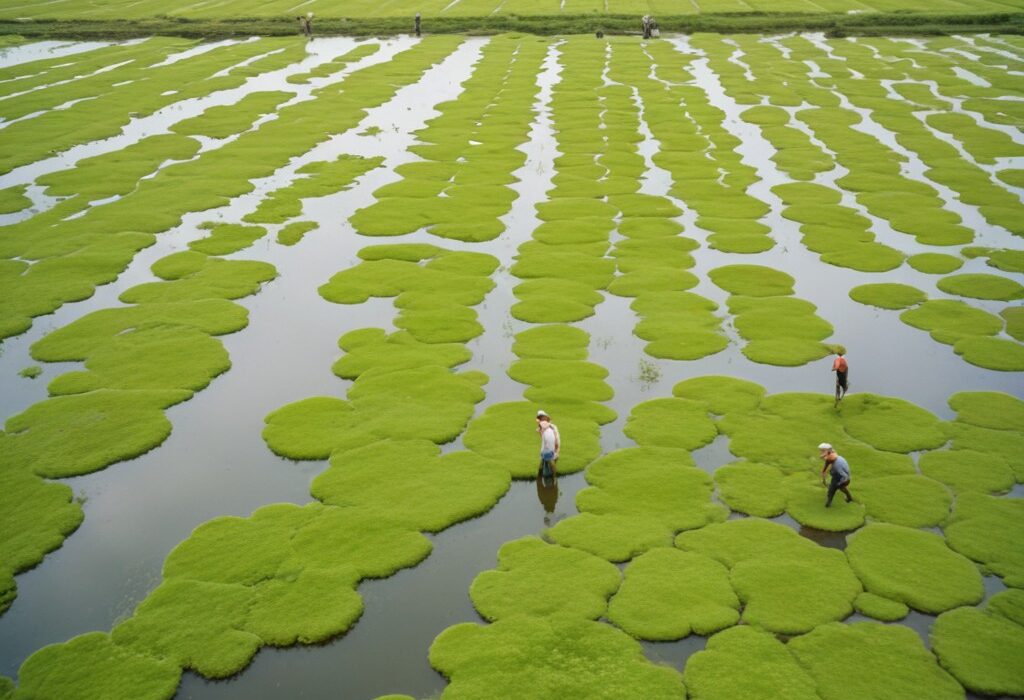Sustainable Farming with Azolla: A Revolution in Agriculture
Introduction
Sustainable farming is no longer a trend but a necessity in today’s world. As the global population continues to grow, the demand for food increases, putting immense pressure on agricultural systems. Sustainable farming practices aim to meet this demand while minimizing environmental impact and preserving natural resources for future generations. Among the many innovations in sustainable agriculture, Azolla stands out as a revolutionary feed solution for livestock. This article delves into the role of Azolla in sustainable farming, its environmental benefits, and how it is transforming agricultural practices worldwide.
The Need for Sustainable Farming
Traditional farming methods often rely heavily on chemical fertilizers, pesticides, and large quantities of water, leading to soil degradation, water pollution, and loss of biodiversity. These practices are not sustainable in the long term and pose a threat to food security. Sustainable farming seeks to address these issues by promoting practices that conserve resources, enhance soil health, and protect ecosystems. Azolla, with its unique properties and benefits, aligns perfectly with the goals of sustainable agriculture.
What is Azolla?
Azolla is a small, fast-growing aquatic fern that has been used for centuries in Asian agriculture as a green manure in rice paddies. It forms a symbiotic relationship with nitrogen-fixing cyanobacteria, which allows it to convert atmospheric nitrogen into a form that plants can use. This makes Azolla a natural fertilizer that enriches the soil and promotes plant growth. In recent years, Azolla has gained attention as a sustainable feed option for livestock due to its high nutritional content and rapid growth rate.
Environmental Benefits of Azolla Cultivation
Azolla offers numerous environmental benefits that make it an ideal component of sustainable farming systems. Firstly, Azolla’s ability to fix nitrogen reduces the need for synthetic fertilizers, which are energy-intensive to produce and contribute to greenhouse gas emissions. By enhancing soil fertility naturally, Azolla helps in maintaining soil health and reducing chemical runoff into water bodies.
Moreover, Azolla’s cultivation requires significantly less water compared to traditional crops. It can be grown in shallow ponds or waterlogged fields, making it suitable for regions with limited water resources. This water-efficient cultivation method helps in conserving water and ensuring sustainable use of this precious resource.
Carbon Sequestration and Climate Change Mitigation
One of the most significant contributions of Azolla to sustainable farming is its role in carbon sequestration. As a fast-growing plant, Azolla absorbs carbon dioxide from the atmosphere and stores it in its biomass. When used as a green manure or feed, the carbon remains sequestered in the soil or within the livestock system. This process helps in reducing atmospheric carbon levels and mitigating the impacts of climate change.
Furthermore, by providing a sustainable alternative to conventional feed, Azolla reduces the reliance on crops like soy and corn, which are often associated with deforestation and habitat loss. By protecting forests and other natural ecosystems, Azolla contributes to the conservation of biodiversity and the fight against climate change.
Integrating Azolla into Farming Systems
Integrating Azolla into farming systems is relatively straightforward and offers multiple benefits. Farmers can cultivate Azolla in dedicated ponds, rice fields, or specially designed pits. The cultivation process involves preparing the growing medium, adding organic fertilizers, and maintaining optimal water conditions. Once established, Azolla grows rapidly and can be harvested every few days.
In addition to using Azolla as livestock feed, farmers can also use it as a green manure to enhance soil fertility. By incorporating Azolla into crop rotations, farmers can improve soil health, increase crop yields, and reduce the need for chemical fertilizers. This integrated approach promotes sustainable farming practices and enhances the overall resilience of agricultural systems.
Success Stories and Global Impact
The impact of Azolla on sustainable farming is evident in numerous success stories from around the world. In India, for example, smallholder farmers have adopted Azolla cultivation to feed their dairy cattle, resulting in increased milk production and reduced feed costs. In Africa, poultry farmers have reported healthier birds and improved egg production after integrating Azolla into their feeding regimen.
These success stories highlight the potential of Azolla to transform agricultural practices and promote sustainability on a global scale. By providing a cost-effective, nutritious, and environmentally friendly feed option, Azolla is helping farmers improve their livelihoods while protecting the planet.
Challenges and Future Prospects
Despite its many benefits, the widespread adoption of Azolla in sustainable farming faces several challenges. These include the need for education and training on Azolla cultivation techniques, initial setup costs, and potential pest and disease issues. However, ongoing research and development efforts are addressing these challenges and exploring new ways to optimize Azolla cultivation and utilization.
The future prospects for Azolla in sustainable farming are promising. With increasing awareness of the importance of sustainable practices, more farmers are likely to adopt Azolla as a key component of their farming systems. Continued innovation and collaboration among researchers, farmers, and policymakers will further enhance the potential of Azolla to support sustainable agriculture and food security.
Conclusion
Azolla fodder represents a revolutionary advancement in sustainable farming. Its numerous environmental benefits, nutritional value, and ease of cultivation make it an ideal feed option for livestock and a valuable addition to sustainable agricultural systems. As more farmers embrace Azolla, the potential for sustainable and profitable livestock farming becomes increasingly evident. By integrating Azolla into farming practices, we can support animal welfare, improve farmer livelihoods, and contribute to environmental conservation.





3 Comments
The Common category includes then following block: Paragraph, image, heading, latest gallery, quote, audio, cover, video. The paragraphs block is the default block type. This is should not have any alignment of any kind. Category and then there are many things to following blocks and many more.
The Common category includes then following block: Paragraph, image, heading, latest gallery, quote, audio, cover, video. The paragraphs block is the default block type. This is should not have any alignment of any kind.
The Common category includes then following block: Paragraph, image, heading, latest gallery, quote, audio, cover, video. The paragraphs block is the default block type. This is should not have any alignment of any kind. Category and then there are many things too following blocks and many more.